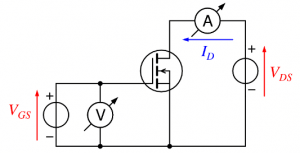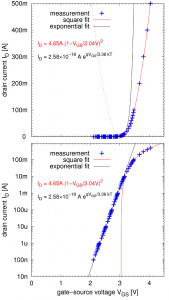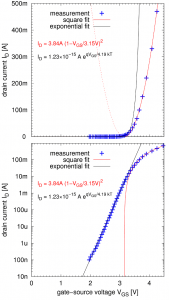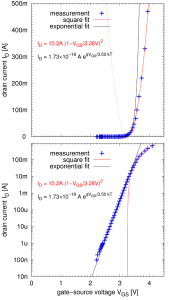I am planning to construct a logarithmic current meter and were yesterday doing some simulations with LTspice. Using a logarithmic converter you can span a wide range of currents with a single readout without the necessity to switch ranges. Of course this has disadvantages as well, but if you know what you are doing it is well worth the effort.
Essentially you have three options
- using an integrated logarithmic amplifier or converter
- using a bipolar transistor
- using a field-effect transistor in deep sub-threshold
You will find plenty of ideas on the internet for the conversion – but most for those are aimed at quite low currents. My project would require a current range of up to 200 mA which exceeds the capability of all integrated logarithmic amplifiers I found so far, at the same time I can sacrifice some accuracy in the low ranges.
After a while I came across the idea to utilize the sub-threshold of a MOSFET. In this region the drain current depends exponentially on the gate-source voltage, not quadratic as for higher currents. Entering a corresponding test circuit into the LTspice simulator nothing happened, as I suspected and then found out as well, sub-threshold behavior is in general not reliably implemented in the device models!
Looking into a datasheet of a power MOSFET you well find out that the behavior in this region is also not considered worth while printing. So all you can do is to measure it yourself.

I quickly wired up a BUZ11 (manufacturer ST, date code A709, Malaysia) to my lab supply with a variable gate voltage and a fixed drain voltage of +5V, one multimeter as an amperemeter between the drain and the power supply and here is the result:

As you can see the drain current ![]() shows at least 4.5 decades of exponential behavior below the threshold voltage of
shows at least 4.5 decades of exponential behavior below the threshold voltage of ![]() , which by the way corresponds quite exactly to the typical threshold voltage according to the datasheet.
, which by the way corresponds quite exactly to the typical threshold voltage according to the datasheet.
Fitting the data I was able to extract the behavior of exactly this transistor at ![]() as
as
![]()
with ![]() and
and ![]() for
for ![]() and
and
![]()
with ![]() ,
, ![]() and
and ![]() .
.
For any practical use be aware of that the sub-threshold behavior is most likely to vary widely between different specimens and that this behavior also is extremely sensitive to temperature variations.

An IRFZ24 (manufacturer IR, date code 8842) at ![]() gives
gives
![]()
with ![]() and
and ![]() for
for ![]() and
and
![]()
with ![]() ,
, ![]() and
and ![]() .
.

An IRFZ46 (manufacturer IR, date code 944D) at ![]() gives
gives
![]()
with ![]() and
and ![]() for
for ![]() and
and
![]()
with ![]() ,
, ![]() and
and ![]() .
.

